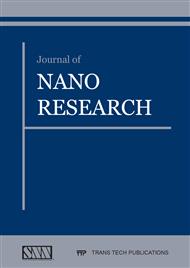[1]
Sang Min Lee, Young Hee Joo, Chang-Il Kim, Influences of film thickness and annealing temperature on properties of sol–gel derived ZnO–SnO2 nanocomposite thin film, Appl. Surf. Sci. 320 (2014) 494-501.
DOI: 10.1016/j.apsusc.2014.09.099
Google Scholar
[2]
Y. Wang, X. Jiang, Y. Xia, Precursor route to poly-crystalline SnO2 nanowires that can be used for gas sensing under ambient conditions, J. Am. Chem. Soc. 125(2003) 16176.
DOI: 10.1021/ja037743f
Google Scholar
[3]
H. J. Snaith, C. Ducati, SnO2-based dye-sensitized hybrid solar cells exhibiting near unity ansorbed photon-to-electron conversion efficiency, Nano Letter 10 (2010) 1259.
DOI: 10.1021/nl903809r
Google Scholar
[4]
W. Zhou, R. Liu, Q. Wan, Q. Zhang, A. Pan, L. Guo, B. Zou, Bound exciton and optical properties of SnO2 one-dimensional nanostructures, J. Phys. Chemistry C 113 (2009) 1719.
DOI: 10.1021/jp808422a
Google Scholar
[5]
W. H. LEE, H. C. SON, P. J. REUCROFT, J. G. LEE, J. W. PARK, Effect of working pressure on the electrochemical performance of thin film SnO2 microbattery anodes deposited by radio frequency magnetron sputtering, J. Mater. Sci. Lett. 20 (2001).
DOI: 10.1016/s0378-7753(00)00382-7
Google Scholar
[6]
Dominguez JE, Fu L, Pan XQ, Epitaxial nanocrystalline tin dioxide thin films grown on (0001) sapphire by femtosecond pulsed laser deposition, Appl. Phys. Lett. 2001, 79 (2001) 614-616.
DOI: 10.1063/1.1386406
Google Scholar
[7]
Sundaram KB, Bhagavat GK, X-ray and electron diffraction studies of chemically vapor-deposited tin oxide films, Thin Solid Films 78 (1981) 35-40.
DOI: 10.1016/0040-6090(81)90415-6
Google Scholar
[8]
Kim KH, Chun JS, X-ray studies of SnO2 prepared by chemical vapor deposition, Thin Solid Films 141 (1986) 287-295.
DOI: 10.1016/0040-6090(86)90356-1
Google Scholar
[9]
Z. Gu, P. Liang, X. Liu, W. Zhang, Y. Le, Characteristics of Sol-Gel SnO2 Films Treated by Ammonia, J. Sol-Gel Sci. Technol. 18 (2000) 159-166.
DOI: 10.1023/a:1008769020768
Google Scholar
[10]
Wei Luo, Jianfeng Deng, Qiuyun Fu, Dongxiang Zhou, Yunxiang Hu, Shuping Gong, Zhiping Zheng, Nanocrystalline SnO2film prepared by the aqueous sol–gel method and its application as sensing films of the resistance and SAW H2S sensor, Sensor. Actuat. B-Chem. 217 (2015).
DOI: 10.1016/j.snb.2014.10.078
Google Scholar
[11]
Hilal Köse, ŞeymaKaraal, AliOsmanAydin, Hatem Akbulu, Structural properties of size-controlled SnO2 nanopowders produced by sol–gel method, Mater. Sci. Semicon. Proc. 38 (2015) 404-412.
DOI: 10.1016/j.mssp.2015.03.028
Google Scholar
[12]
S. Sujatha Lekshmy, K. Joy, SnO2 thin films doped indium prepared by the sol–gel method: structure, electrical and photoluminescence properties, J. Sol-Gel Sci. Technol. 67 (2013) 29-38.
DOI: 10.1007/s10971-013-3047-0
Google Scholar


